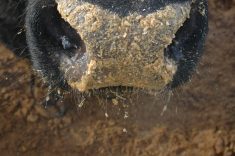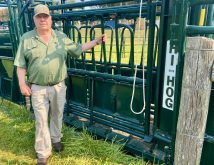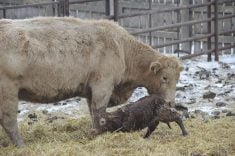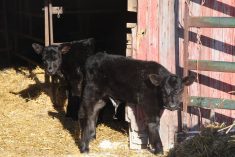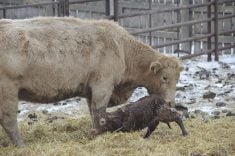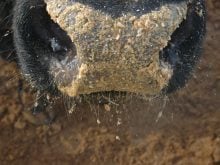Foot problems are the biggest issue for bulls next to reproduction culls and need to be part of a breeding assessment
Feet and legs need to be checked when bulls are evaluated for breeding soundness.
Producers select for strong feet and legs because structural soundness of the feet and legs is vital so bulls can travel and mount females in heat.
“If problems are starting in a young one, it is different from a five- or six-year-old that is starting to show wear and tear,” said veterinarian Roy Lewis.
Next to reproduction culls, feet problems are the next biggest problem, said Lewis.
Some problems are heritable but a mature animal may have had an injury and lameness ensues.
Read Also

Canadian Food Inspection Agency extends chronic wasting disease control program consultation deadline
Date extended for consultation period of changes to CWD program
Poorly conformed feet and legs like sickle hock are heritable and could show up in daughters.
Mature bulls may suffer from overgrowth of the horny hoof that requires trimming. The extra growth on the foot makes it difficult for the bull to walk.
The sole of the hoof is normally concave with the outside rim of the hoof bearing the weight of the animal. Overgrowth of the horn-like material interferes with this. After hoof trimming, the outer rim of the hoof should be left slightly longer than the outer edges next to the cleft between the toes.
The environmental and heritable factors can contribute to cracks in the hooves, for example. Walking in dry sandy areas may cause cracks that can lead to sole abscesses. Other foot problems may develop when walking on soft surfaces and the foot does not get worn down.
“There is a fine line between wearing it off and wearing it off evenly and developing problems,” he said.
Animals may appear lame because of a stumble, and those injuries can heal up on their own. Painkillers may be used.
Foot rot is often the diagnosis, and antibiotics are used to treat the problem.
The true foot rot is between the toes and causes swollen feet. This responds well to antibiotics.
“They are probably treating more than they need to,” Lewis said.
An emerging disease is hairy heel wart, or interdigital dermatitis. A wet environment can cause a painful condition that is difficult to treat.
However, some conditions do not need medicine.
An appointment with a certified hoof trimmer may be a better idea. If animals have small injuries or cracks in the hoof a good trim can help improve the bull’s longevity.
“A lot of guys have paid tons of money for these bulls so if a preventive trim will get them off in the breeding season in better shape, that goes a long ways towards lengthening their life and not having problems develop,” said Lewis.
Veterinarians should try to work with hoof trimmers, who can alert them to problems that need extra work, such as removing corns.
Modern bulls are sometimes almost too big for the size of their feet. More weight and pressure are placed on the foot, which may lead to future problems.
Big bulls can get sore feet if they do not move enough.
Housing them in a pen where they get exercise on a harder surface to keep their feet in better shape is a good idea. Installing aggregate cement in pens keeps things clean and requires less bedding.
“I think it is really going to improve foot health. It is going to keep them on a harder surface where they wear the feet down more evenly rather than running on pasture,” Lewis said.
Nutrition can fine tune the health of bulls, but it may not be directly related to foot care.
Most people have balanced rations, but there are areas where problems might occur. However, other problems are more likely to show up first if an animal has a deficiency.
“The feet are a slow thing to show a problem,” he said.
Alberta Agriculture recommends bulls receive energy, protein, calcium, phosphorous and vitamins A, D and E in their rations. Winter is a good time to build up bulls so that they have a condition score of three to 3.5 by breeding time.
Body structure, fluid balance, nerve function and muscle contraction all rely on adequate levels of macrominerals.
Calcium is needed for strong bones and skeletal soundness. It also plays an essential part in claw horn integrity.
Sulfur is a molecular component of protein and is found in every tissue and organ in the body. It is a component of reinforcing bonds in collagen, keratin-associated proteins and cells enveloping proteins.
A vitamin A deficiency can cause inflammation of the coronary band of the hoof.
Biotin (vitamin B) is important in keratin formation and cell-to-cell adhesion in the outer horn layer. It acts like a cementing substance. Biotin deficiency has been associated with foot lesions and toe cracks in cattle.
Vitamin D and phosphorous are need for calcium absorption.
Zinc is a valuable micronutrient that functions as a component of natural enzymes in the body. It stabilizes cell membranes, binds proteins to membranes and controls gene transcription and immune function.




